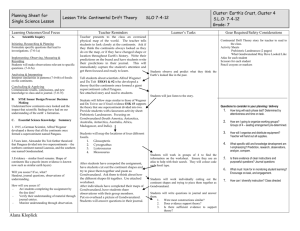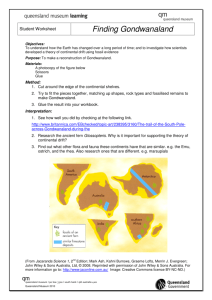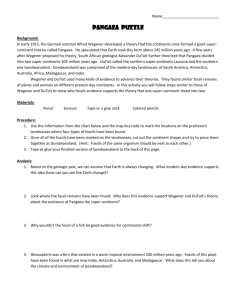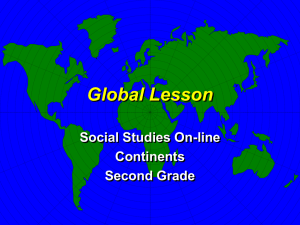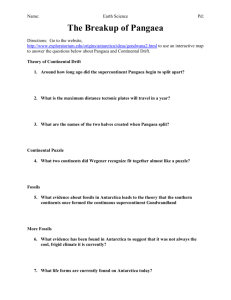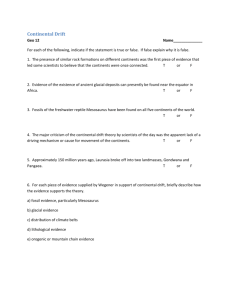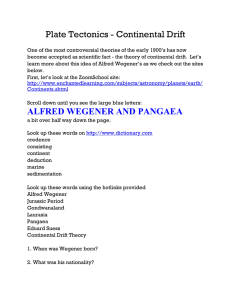gondwanaland and continental drift
advertisement
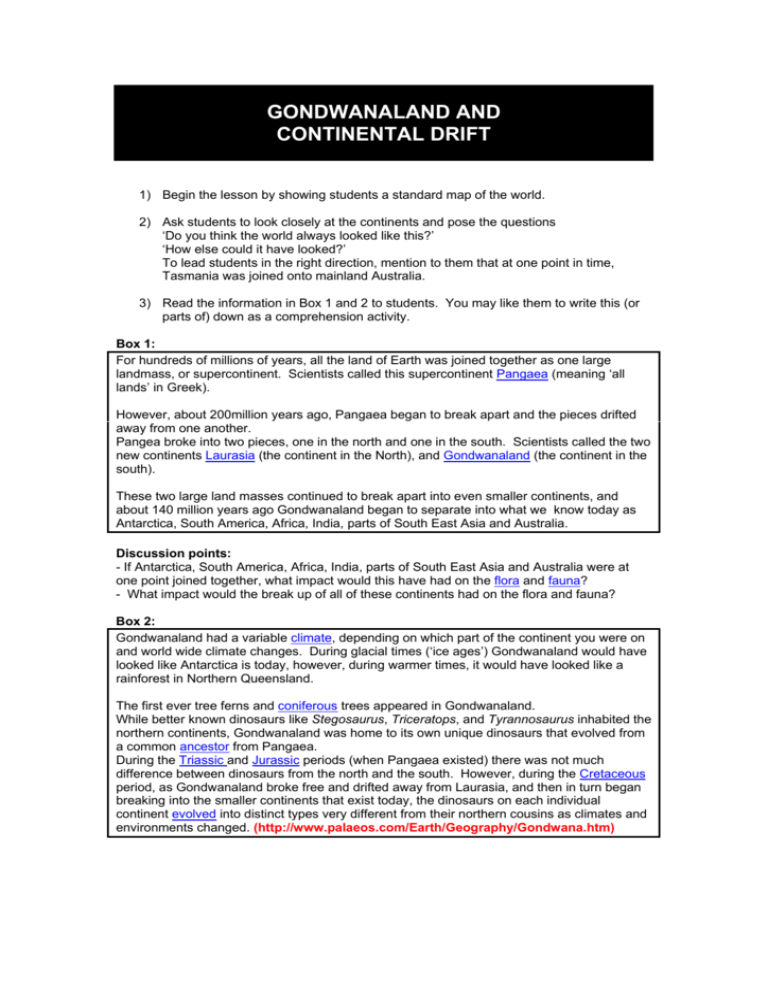
GONDWANALAND AND CONTINENTAL DRIFT 1) Begin the lesson by showing students a standard map of the world. 2) Ask students to look closely at the continents and pose the questions ‘Do you think the world always looked like this?’ ‘How else could it have looked?’ To lead students in the right direction, mention to them that at one point in time, Tasmania was joined onto mainland Australia. 3) Read the information in Box 1 and 2 to students. You may like them to write this (or parts of) down as a comprehension activity. Box 1: For hundreds of millions of years, all the land of Earth was joined together as one large landmass, or supercontinent. Scientists called this supercontinent Pangaea (meaning ‘all lands’ in Greek). However, about 200million years ago, Pangaea began to break apart and the pieces drifted away from one another. Pangea broke into two pieces, one in the north and one in the south. Scientists called the two new continents Laurasia (the continent in the North), and Gondwanaland (the continent in the south). These two large land masses continued to break apart into even smaller continents, and about 140 million years ago Gondwanaland began to separate into what we know today as Antarctica, South America, Africa, India, parts of South East Asia and Australia. Discussion points: - If Antarctica, South America, Africa, India, parts of South East Asia and Australia were at one point joined together, what impact would this have had on the flora and fauna? - What impact would the break up of all of these continents had on the flora and fauna? Box 2: Gondwanaland had a variable climate, depending on which part of the continent you were on and world wide climate changes. During glacial times (‘ice ages’) Gondwanaland would have looked like Antarctica is today, however, during warmer times, it would have looked like a rainforest in Northern Queensland. The first ever tree ferns and coniferous trees appeared in Gondwanaland. While better known dinosaurs like Stegosaurus, Triceratops, and Tyrannosaurus inhabited the northern continents, Gondwanaland was home to its own unique dinosaurs that evolved from a common ancestor from Pangaea. During the Triassic and Jurassic periods (when Pangaea existed) there was not much difference between dinosaurs from the north and the south. However, during the Cretaceous period, as Gondwanaland broke free and drifted away from Laurasia, and then in turn began breaking into the smaller continents that exist today, the dinosaurs on each individual continent evolved into distinct types very different from their northern cousins as climates and environments changed. (http://www.palaeos.com/Earth/Geography/Gondwana.htm) 4) Ask students if they any idea how we know of the existence of Pangaea, Laurasia and Gondwanaland. What types of ‘clues’ could exist in our modern world that might suggest the existence of the supercontinents? 5) Read out loud to students Box 3 and then complete Activity 1: ‘What Evidence Can You Find?’ Box 3 In 1912, a German scientist called Alfred Wegner developed a theory that the continents once formed a giant supercontinent that he called Pangaea. He speculated the world took this form 240million years ago based on 5 major bodies of evidence. Some years later, Alexander Du Toit further theorised that Pangaea divided into the two supercontinents; Laurasia and Gondwanaland, around 205million years ago. Discussion points: - Discuss with students the meaning of the word ‘theory’ - How do you support your theory, or prove if it is true? - Introduce the idea of ‘evidence’ ACTIVITY: What evidence can you find? Pangaea, Laurasia and Gondwanaland 1) Explain to students that they are going to see if they can find evidence to support the theorys that there was once one giant supercontinent, which broke into two pieces and the broke further apart into the continents we know today. Tell students they will focus mainly on Gondwanaland. 2) Hand out activity sheet titled ‘Gondwanaland – What did it look like?’. Complete the activity. 3) Explain that the students will be mapping the location of 4 different types of fossils by following the instructions on the handout**: - Glossopteris: a fern found on the southern continents - Cynognathus: a land reptile found in Africa and South America - Lystrosaurus: aland reptile found in Africa, Antarctica and South America - Mesosaurus: a freshwater swimming reptile found in Africa and South America **Ask students to use an atlas or interactive mapping system (eg: googlemaps.com) to locate the places listed in the chart and mark on the sheet. Contintental Drift 4) Using the maps the students created have them compare their versions of Gondwanaland - Are most maps similar? - Ask students to present their ‘evidence’ as to why they have presented their map in the manner they have. 5) Hand out to students an actual map of Gondwanaland (Attachment 1). - how close was your map? - discuss Cynognathus, Glossopteris, Lystrosaurus and Mesosaurus; why are they in specific areas only? - once the Gondwanaland broke apart, what would have happened to these plants and animals? (You may wish to discuss this very generally, or use it to introduce the concept of adaptation and plant/animal evolution). Discussion points: - Is the presence of the same plants and animals in different countries enough evidence to prove the existence of supercontinents? - Can you think of any other reasons how/why these plants and animals ended up on different countries, thousands of miles apart? Tell students that over the past century scientists have used many kinds of evidence to create and advance their theories, the strongest evidence being that similar fossil remains of plants and animals have been found on the present day continents, now separated by oceans. THE EVOLUTION OF A THEORY: CONTINENTAL DRIFT Continental Drift is the movement of the Earth’s continents in relation to one another. 1660: Francis Bacon Noticed that the coastlines of Africa and South America had similar, matching shapes 1858: Antonio Snider Published first map showing Africa and South America joined together – he theorised they broke apart during Noah’s flood. 1904: Eduard Suess Found that the rock structures on either side of the Atlantic Ocean were very similar – but this was explained by the collapse below sea level of a supposed continent in between, called ‘Atlantis’. 1910: F.B. Taylor He envisaged a ‘mighty creeping movement’ of the Earth’s crust and collisions with other continents to explain certain mountains across the world. Eg: the Himalayas and The Alps. 1912: Alfred Wegener His idea was called ‘Continental Displacement’ which later was titled ‘Continental Drift’. His book contained five major lines of evidence: 1) the jigsaw fit – the very closest match between the coastlines of South America and Africa 2) matching of the geological patterns from either side of the south Atlantic (ie: all the southern continents can be pieced together as per your map) 3) fossil evidence; the same animal and plant fossils being located thousands of miles apart on separate continents) 4) Continental movement – the demonstration of continents slowly moving further apart over a number of years. 1937: Alexander Du Toit Compiled significant geological evidence to support the ‘continental drift’ idea (ie: matching rocks on either side of the Atlantic) 1956: SK Runcorn et al Evidence showed that the magnetic poles (North and South Pole) of the Earth had moved. It was later shown that it was not the Poles that had moved, but the continents! 1962: Harry Hess Proposed that new ocean floor was created in the centre of oceans, and then moved sideways. 1965: J. Tuzo Wilson Proposed that the Earth was divided into several large ‘plates’ that fitted together like a puzzle, with the pieces moving apart as the sea floors spread. 1967: Jason Morgan, Dan McKenzie and Xavier le Pichon Developed all the earlier ideas in to the current Continental Drift/Plate Tectonic Theory EXTENSTION ACTIVITY 1) What characteristics do you think enable a plant or animal to survive the breakup of a continent? Try to think of at least 2 characteristics. 2) a) Do you think that the breakup of Pangaea into Gondwanaland and Laurasia affected organisms originally living on Pangaea? b) Do you think that the breakup of Gondwanaland into the southern continents affected the organisms living in Gondwanaland? Give evidence to support your ideas. 3) Do you think the break up of Pangaea during the Jurassic period led to the extinction for some dinosaurs and the evolution of the dinosaurs? Explain your answer. 4) Scientists have evidence that Glossipteris was found in what is now India, Antarctica, Australia and Madagascar. What does this tell you about Glossopteris and/or the climate and environment of Gondwanaland? 5) Based on geologic past, we can assume that Earth is always changing. What modern-day evidence supports this idea? Hint: thing about natural disasters. Where do the often occur? GONDWANALAND – WHAT DID IT LOOK LIKE? 1) Cut out the shapes of the following continents and countries from the activity sheet: South America, Antarctica, Australia, Africa, Madagascar and India. 2) Using the key code and chart below, mark the locations of the 4 different fossils on the continents/countries. Glossopteris = Green ‘G’ Lystrosaurus = Red ‘L’ Cynognathus = Orange ‘C’ Mesosaurus = Blue ‘M’ Fossil Name Description Present day location Glossopteris A fern - Southern tip of India near Madurai - Prince Harald Coast, Antarctica - Southern tip of Madagascar - Oates Coast, Antarctica - Southeaster Australia (near Melbourne) Cynognathus A land reptile - Southeaster Argentina (near Bahia Blanca) - Southwestern South Africa (near Cape Town) Lystrosaurus A land reptile Mesosaurus A freshwater reptile - Wilhelm IICoast, Antarctica - Madagascar, north of Antananarivo - Central India (between Bangalore and Hyderabad) Eastern Tanzania (near Dar es Salaam) - Eastern Brazil (near Salvadore) - Cameroon, West Africa 3) In the space below, arrange the continents into what you think Gondwanaland may have looked like.
